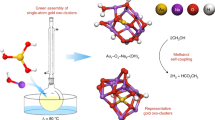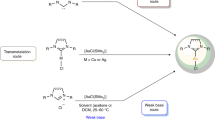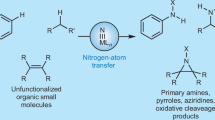Abstract
Reductive elimination of carbon–carbon bonds occurs in numerous metal-catalysed reactions. This process is well documented for a variety of transition metal complexes. However, carbon–carbon bond reductive elimination from a limited number of Au(III) complexes has been shown to be a slow and prohibitive process that generally requires elevated temperatures. Herein we show that oxidation of a series of mono- and bimetallic Au(I) aryl complexes at low temperature generates observable Au(III) and Au(II) intermediates. We also show that aryl–aryl bond reductive elimination from these oxidized species is not only among the fastest observed for any transition metal, but is also mechanistically distinct from previously studied alkyl–alkyl and aryl–alkyl reductive eliminations from Au(III).
This is a preview of subscription content, access via your institution
Access options
Subscribe to this journal
Receive 12 print issues and online access
$259.00 per year
only $21.58 per issue
Buy this article
- Purchase on Springer Link
- Instant access to full article PDF
Prices may be subject to local taxes which are calculated during checkout






Similar content being viewed by others
Change history
22 April 2014
In our Article we described the preparation and observation in situ of a complex of the type [Au(aryl)2Cl(PPh3)], which is similar to a series of cyclometallated Au(iii) complexes that undergo aryl–aryl and aryl–alkyl reductive elimination reported in two papers that we inadvertently omitted from our reference list: Vicente, J., Bermudez, M. D., Escribano, J., Carrillo, M. P. & Jones, P. G. Synthesis of intermediates in the C–H activation of acetone with 2-phenylazophenylgold(iii) complexes and in the C–C coupling of aryl groups from diarylgold(iii) complexes. Crystal and molecular structures of [Au{C6H3(N=NC6H4Me-4')-2-Me-5}(acac-C)Cl](acac = acetylacetonate), cis-[Au(C6H4N=NPh-2)Cl2(PPh3)] and [Au(C6H4CH2NMe2-2)(C6F5)Cl]. J. Chem. Soc. Dalton Trans. 3083–3089 (1990). Vicente, J., Bermudez, M. D. & Escribano, J. Gold in organic synthesis. preparation of symmetrical and unsymmetrical biaryls via C–C coupling from cis-diarylgold(iii) complexes. Organometallics 10, 3380–3384 (1991).
References
Brown, J. M. & Cooley, N. A. Carbon–carbon bond formation through organometallic elimination reactions. Chem. Rev. 88, 1031–1046 (1988).
Tsou, T. T. & Kochi, J. K. Mechanism of biaryl synthesis with nickel complexes. J. Am. Chem. Soc. 101, 7547–7560 (1979).
Komiya, S., Abe, Y., Yamamoto, A. & Yamamoto, T. Phosphine-induced reductive elimination from cis-arylmethylnickel(II) complexes having a 1,2-bis(dimethylphosphino)ethane ligand. Organometallics 2, 1466–1468 (1983).
Komiya, S., Akai, Y., Tanaka, K., Yamamoto, T. & Yamamoto, A. Reductive elimination of aryl carboxylates from acyl(aryloxy)nickel(II) and -palladium(II) complexes. Organometallics 4, 1130–1136 (1985).
Lin, B. L., Clough, C. R. & Hillhouse, G. L. Interactions of aziridines with nickel complexes: oxidative-addition and reductive-elimination reactions that break and make C–N bonds. J. Am. Chem. Soc. 124, 2890–2891 (2002).
Jin, L., Zhang, H., Li, P., Sowa, J. R. Jr & Lei, A. What is the rate of the Csp2–Csp2 reductive elimination step? Revealing an unusually fast Ni-catalyzed Negishi-type oxidative coupling reaction. J. Am. Chem. Soc. 131, 9892–9893 (2009).
Milstein, D. & Stille, J. K. Mechanism of reductive elimination. Reaction of alkylpalladium(II) complexes with tetraorganotin, organolithium, and Grignard reagents. Evidence for palladium(IV) intermediacy. J. Am. Chem. Soc. 101, 4981–4991 (1979).
Moravskiy, A. & Stille, J. K. Mechanisms of 1,1-reductive elimination from palladium: elimination of ethane from dimethylpalladium(II) and trimethylpalladium(IV). J. Am. Chem. Soc. 103, 4182–4186 (1981).
Low, J. J. & Goddard, W. A. Theoretical studies of oxidative addition and reductive elimination. 3. Carbon–hydrogen and carbon–carbon reductive coupling from palladium and platinum bis(phosphine) complexes. J. Am. Chem. Soc. 108, 6115–6128 (1986).
Byers, P. K., Canty, A. J., Crespo, M., Puddephatt, R. J. & Scott, J. D. Reactivity and mechanism in oxidative addition to palladium(II) and reductive elimination from palladium(IV) and an estimate of the palladium–methyl bond energy. Organometallics 7, 1363–1367 (1988).
Widenhoefer, R. A. & Buchwald, S. L. Electronic dependence of C–O reductive elimination from palladium (aryl)neopentoxide complexes. J. Am. Chem. Soc. 120, 6504–6511 (1998).
Osakada, K., Onodera, H. & Nishihara, Y. Diarylpalladium complexes with a cis structure. Formation via transmetalation of arylboronic acids with an aryliodopalladium complex and intramolecular coupling of the aryl ligands, affording unsymmetrical biaryls. Organometallics 24, 190–192 (2005).
Hartwig, J. F. Electronic effects on reductive elimination to form carbon–carbon and carbon–heteroatom bonds from palladium(II) complexes. Inorg. Chem. 46, 1936–1947 (2007).
Pérez-Rodríguez, M. et al. C–C reductive elimination in palladium complexes, and the role of coupling additives. A DFT study supported by experiment. J. Am. Chem. Soc. 131, 3650–3657 (2009).
Racowski, J. M., Dick, A. R. & Sanford, M. S. Detailed study of C–O and C–C bond-forming reductive elimination from stable C2N2O2-ligated palladium(IV) complexes. J. Am. Chem. Soc. 131, 10974–10982 (2009).
Brown, M. P., Puddephatt, R. J. & Upton, C. E. E. Mechanism of reductive elimination of ethane from some halogenotrimethylbis(tertiary phosphine)platinum(IV) complexes. J. Chem. Soc. Dalton Trans. 2457–2465 (1974).
Abis, L., Sen, A. & Halpern, J. Intramolecular reductive elimination of alkanes from cis-hydridoalkylbis(phosphine)platinum(II) complexes. J. Am. Chem. Soc. 100, 2915–2916 (1978).
Stahl, S. S., Labinger, J. A. & Bercaw, J. E. Formation and reductive elimination of a hydridoalkylplatinum(IV) intermediate upon protonolysis of an alkylplatinum(II) complex. J. Am. Chem. Soc. 117, 9371–9372 (1995).
Shekhar, S. & Hartwig, J. F. Distinct electronic effects on reductive eliminations of symmetrical and unsymmetrical bis-aryl platinum complexes. J. Am. Chem. Soc. 126, 13016–13027 (2004).
Bercaw, J. E., Chen, G. S., Labinger, J. A. & Lin, B-L. Protonolysis of platinum(II) and palladium(II) methyl complexes: a combined experimental and theoretical investigation. Organometallics 29, 4354–4359 (2010).
Lanci, M. P., Remy, M. S., Lao, D. B., Sanford, M. S. & Mayer, J. M. Modulating sterics in trimethylplatinum(IV) diimine complexes to achieve C–C bond-forming reductive elimination. Organometallics 30, 3704–3707 (2011).
Liberman-Martin, A. L., Bergman, R. G. & Tilley, T. D. A remote Lewis acid trigger dramatically accelerates biaryl reductive elimination from platinum complex. J. Am. Chem. Soc. 135, 9612–9615 (2013).
Tamaki, A., Magennis, S. A. & Kochi, J. K. Catalysis by gold. Alkyl isomerization, cis–trans rearrangement, and reductive elimination of alkylgold(III) complexes. J. Am. Chem. Soc. 96, 6140–6148 (1974).
Komiya, S., Albright, T. A., Hoffmann, R. & Kochi, J. K. Reductive elimination and isomerization of organogold complexes. Theoretical studies of trialkylgold species as reactive intermediates. J. Am. Chem. Soc. 98, 7255–7265 (1976).
Komiya, S. & Kochi, J. K. Electrophilic cleavage of organogold complexes with acids. The mechanism of the reductive elimination of dialkyl(aniono)gold(III) species. J. Am. Chem. Soc. 98, 7599–7607 (1976).
Kuch, P. L. & Tobias, R. S. Synthesis of cationic dialkylgold(III) complexes: nature of the facile reductive elimination of alkane J. Organomet. Chem. 122, 429–446 (1976).
Tkatchouk, E., Mankad, N. P., Benitez, D., Goddard, W. A. & Toste, F. D. Two metals are better than one in the gold-catalyzed oxidative heteroarylation of alkenes. J. Am. Chem. Soc. 133, 14293–14300 (2011).
Mazany, A. M. & Fackler, J. P. Jr. Isomeric species of the dinuclear iodogold complex [AuCH2P(S)PhI]2. Mixed-valent gold(I)/gold(III) and isovalent gold(II)-gold(II) complexes with the same methylenethiophosphinate ligand. J. Am. Chem. Soc. 106, 801–802 (1984).
Fackler, J. P. & Trzcinska-Bancroft, B. Isomerization of a symmetrical metal–metal bonded gold(II) ylide dimer to a mixed-valence gold(III)/gold(I) species. Organometallics 1985, 1891–1893.
Murray, H. H. et.al. Synthesis and X-ray crystal structures of [Au(CH2)2PPh2]2(CF3)2, [Au(CH2)2PPh2]2(C6F5)2, and [PPN][Au(C6F5)4]: two dinuclear gold(II) ylide complexes containing alkyl and aryl ligands and a tetrakis(pentafluorophenylaurate(III)) anion complex. Inorg. Chem. 26, 357–363 (1987).
Khan, N. I., Fackler, J. P. Jr, King, C., Wang, J. C. & Wang, S. Synthesis and characterization of the luminescent dithiolate-bridged dimer [n-Bu4N]2[Au(i-MNT)]2 (i-MNT=S2C2(CN)22) and its structurally characterized, metal–metal-bonded gold(II) oxidation product [Ph4As]2[Au(i-MNT)Cl]2 . Inorg. Chem. 27, 1672–1673 (1988).
King, C., Wang, J-C., Khan, N. I. & Fackler, J. P. Jr. Luminescence and metal–metal interactions in binuclear gold(I) compounds. Inorg. Chem. 28, 2145–2149 (1989).
Abdou, H. E., Mohamed, A. A. & Fackler J. P. Jr. Synthesis and X-ray structures of dinuclear and trinuclear gold(I) and dinuclear gold(II) amidinate complexes. Inorg. Chem. 44, 166–168 (2005).
Abdou, H. E., Mohamed, A. A. & Fackler, J. P. Jr. Oxidative addition of small molecules to a dinuclear Au(I) amidinate complex, Au2[(2,6-Me2Ph)2N2CH]2. Syntheses and characterization of Au(II) amidinate complexes including one which possesses Au(II)-oxygen bonds. Inorg. Chem. 46, 9692–9699 (2007).
Bardaji, M., Gimeno, M. C., Jones, P. G., Laguna, A. & Laguna, M. Dinuclear gold(II) complexes containing two different bridging ligands. Crystal structure of [Au2{μ-(CH2)2PPh2}{μ-S2CN(CH2Ph)2}Br2]. Organometallics 13, 3415–3419 (1994).
Bardaji, M., Jones, P. G., Laguna, A. & Laguna, M. Heterobridged dinuclear gold(I) and gold(II) complexes with xanthate ligands. X-ray structures of [Au2{μ-(CH2)2PPh2}(μ-S2COiPr)] and [Au2{μ-(CH2)2PPh2}(μ-S2COMe)Br2]. Organometallics 14, 1310–1315 (1995).
Usón, R., Laguna, A., Laguna, M., Jiminez, J. & Jones, P. G. Alternative synthesis of binuclear gold(II) ylide complexes: cationic gold(II) complexes. X-ray crystal structures of [{Au(CH2)2PPh2}2Br2] and [{Au(CH2)2PPh2}2(PPh3)2][CLO4]2 . J. Chem. Soc. Dalton Trans. 1361–1365 (1991).
Usón, R., Laguna, A., Laguna, M. & Fraile, M. N. Mono- and bi-nuclear gold(I), gold(II), and gold(III) perhalogenoaryl complexes with the ligand bis(diphenylphosphino)amine. Crystal and molecular structure of μ-[bis(diphenylphosphino)amine]-dichlorobis(pentafluorophenyl)digold(II). J. Chem. Soc. Dalton Trans. 291–296 (1986).
Bennett, M. A., Bhargava, S. K., Hockless, D. C. R., Welling, L. L. & Willis, A. C. Dinuclear cycloaurated complexes containing bridging (2-diphenylphosphino)phenylphosphine and (2-diethylphosphino)phenylphosphine, C6H4PR2 (R=Ph, Et). Carbon–carbon bond formation by reductive elimination at a gold(II)–gold(II) center. J. Am. Chem. Soc. 118, 10469–10478 (1996).
Hashmi, A. S. K., Blanco, M. C., Fischer, D. & Bats, J. W. Gold catalysis: evidence for the in-situ reduction of gold(III) during the cyclization of allenyl carbinols. Eur. J. Org. Chem. 1387–1389 (2006).
Soriano, E. & Marco-Contelles, J. Computational Mechanisms of Au and Pt Catalyzed Reactions (Topics in Current Chemistry 302, Springer, 2011).
Gorin, D. J. & Toste, F. D. Relativistic effects in homogeneous gold catalysis. Nature 446, 395–403 (2007).
Martin, R. & Buchwald, S. L. Pd-catalyzed Kumada–Corriu cross-coupling reactions at low temperatures allow the use of Knochel-type Grignard reagents J. Am. Chem. Soc. 129, 3844–3845 (2007).
Canty, A. J. Organopalladium and platinum chemistry in oxidising milieu as models for organic synthesis involving the higher oxidation states of palladium. Dalton Trans. 10409–10417 (2009).
Powers, D. C. & Ritter, T. Bimetallic redox synergy in oxidative palladium catalysis. Acc. Chem. Res. 45, 840–850 (2012).
Wass, D. F. et al. High activity ethylene trimerisation catalysts based on diphosphine ligands. Chem. Commun. 858–859 (2002).
Esswein, A. J., Veige, A. S. & Nocera, D. G. A photocycle for hydrogen production from two-electron mixed-valence complexes. J. Am. Chem. Soc. 127, 16641–16651 (2005).
Whitesides, G. M., Casey, C. P. & Krieger, J. K. The thermal decomposition of vinylic copper(I) and silver(I) organometallic compounds. J. Am. Chem. Soc. 93, 1379–1389 (1971).
Goldwhite, H. & Rowsell, D. G. Rotational barriers about phosphorus–nitrogen bonds. J. Chem. Soc. D. 713 (1969).
Usón, R., Laguna, A. & Vicente, J. Novel anionic gold(I) and gold(III) organocomplexes. J. Organomet. Chem. 131, 471–475 (1977).
Acknowledgements
This research was supported in part by a grant from the National Institutes of Health (NIH) General Medical Sciences (RO1 GM073932). We thank the National Science Foundation (predoctoral fellowship to W.J.W., grant no. DGE 1106400) and NIH (postdoctoral fellowship to M.S.W., grant no. F32 GM103238-02) for funding. We thank R. G. Bergman, N. P. Mankad and M. D. Levin for helpful discussions, and A. DiPasquale for crystallographic assistance.
Author information
Authors and Affiliations
Contributions
M.S.W. and W.J.W. conceived, designed and performed the experiments, analysed the data and wrote the manuscript; M.S.W. derived kinetic models; W.J.W. performed the crystallographic analysis. F.D.T. supervised the project.
Corresponding author
Ethics declarations
Competing interests
The authors declare no competing financial interests.
Supplementary information
Supplementary information
Supplementary information (PDF 2613 kb)
Supplementary information
Crystallographic data for compound 5. (CIF 24 kb)
Supplementary information
Crystallographic data for compound 8. (CIF 19 kb)
Supplementary information
Crystallographic data for compound 11. (CIF 19 kb)
Rights and permissions
About this article
Cite this article
Wolf, W., Winston, M. & Toste, F. Exceptionally fast carbon–carbon bond reductive elimination from gold(III). Nature Chem 6, 159–164 (2014). https://doi.org/10.1038/nchem.1822
Received:
Accepted:
Published:
Issue Date:
DOI: https://doi.org/10.1038/nchem.1822
This article is cited by
-
A dodecamethoxy[6]cycloparaphenylene consisting entirely of hydroquinone ethers: unveiling in-plane aromaticity through a rotaxane structure
Nature Communications (2023)
-
Gold-catalyzed four-component multifunctionalization of alkynes
Nature Communications (2023)
-
Dinuclear gold-catalyzed C-H bond functionalization of cyclopropenes
Science China Chemistry (2021)
-
Rational development of catalytic Au(I)/Au(III) arylation involving mild oxidative addition of aryl halides
Nature Communications (2017)
-
Stable gold(III) catalysts by oxidative addition of a carbon–carbon bond
Nature (2015)



